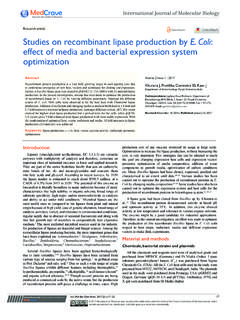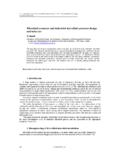Transcription of Claire-Anne Siegrist - WHO
1 16To generate vaccine -mediated protection is a complex chal-lenge. Currently available vaccines have largely been devel-oped empirically, with little or no understanding of how they activate the immune system . Their early protective efficacy is primarily conferred by the induction of antigen-specific anti-bodies (Box ). However, there is more to antibody-mediated protection than the peak of vaccine -induced antibody titers. The quality of such antibodies ( , their avidity, specificity, or neutralizing capacity) has been identi-fied as a determining factor in efficacy. Long-term protection requires the persistence of vaccine antibodies above protective thresholds and/or the maintenance of immune memory cells capable of rapid and effective reactivation with subsequent microbial exposure.
2 The determinants of immune memory induction, as well as the relative contribution of persisting antibodies and of immune memory to protection against spe-cific diseases, are essential parameters of long-term vaccine predominant role of B cells in the efficacy of current vaccines should not overshadow the importance of T-cell responses: T cells are essential to the induction of high-affinity antibodies and immune memory, directly contribute to the protection conferred by current vaccines such as bacille Calmette-Gu rin (BCG), may play a more critical role than previously anticipated for specific diseases like pertussis, and will be the prime effectors against novel vaccine targets with predominant intracellular localization such as methods have emerged allowing the assessment of a growing number of vaccine -associated immune parameters, including in humans.
3 This development raises new questions about the optimal markers to assess and their correlation with vaccine -induced protection. The identification of mechanistic immune correlates or at least surrogates of vaccine efficacy is a major asset for the development of new vaccines or the optimization of immunization strategies using available vac-cines. Thus, their determination generates a considerable amount of interest. During the last decade, the increased awareness of the complexity of the immune system and its determinants, including at the host genetic level, indicated that using system biology approaches to assess how various processes and networks interact in response to immunization could prove more illustrative than trying to isolate and char-acterize a few components of vaccine Delineating the specific molecular signatures of vaccine immunogenicity is beginning to highlight novel correlates of protective immu-nity and better explain the heterogeneity of vaccine responses in a population.
4 The tailoring of vaccine strategies for specific vulnerable populations, including very young, elderly, and immunosuppressed populations, also largely relies on a better understanding of what supports or limits vaccine efficacy under special circumstances at the population and individ-ual levels. Lastly, the exponential development of new vaccines raises many questions that are not limited to the targeted diseases and the potential impacts of their prevention, but that address the specific and nonspecific impacts of such vaccines on the immune system and, thus, on health in general. These immune-related concerns have largely spread into the population, and questions related to the immunological safety of vaccines that is, their capacity for triggering 2 non antigen-specific responses possibly leading to allergy, autoimmunity, or even premature death are being raised.
5 Certain off-targets effects of vaccines have also been recog-nized and call for studies to quantify their impact and identify the mechanisms at play. The objective of this chapter is to extract from the complex and rapidly evolving field of immu-nology the main concepts that are useful to better address these important DO VACCINES MEDIATE PROTECTION?Vaccines protect by inducing effector mechanisms (cells or molecules) capable of rapidly controlling replicating patho-gens or inactivating their toxic components. vaccine -induced immune effectors (Table ) are essentially antibodies produced by B lymphocytes capable of binding specifically to a toxin or a Other potential effectors are cyto-toxic CD8+ T lymphocytes that may limit the spread of infec-tious agents by recognizing and killing infected cells or secreting specific antiviral cytokines and CD4+ T-helper (Th) lymphocytes.
6 These Th cells may contribute to protection through cytokine production and provide support to the gen-eration and maintenance of B and CD8+ T-cell responses. Effector CD4+ Th cells were initially subdivided into T-helper 1 (Th1) or T-helper 2 (Th2) subsets depending on their main cytokine production (interferon- or interleukin [IL]-4), respectively. This dichotomy became outdated as Th cells were increasingly shown to include a large number of subsets with distinct cytokine-producing and homing capacities (see Table ).3 A recently identified critical subset of vaccine -induced CD4+ Th cells are follicular T-helper (Tfh) cells: they are spe-cially equipped and positioned in the lymph nodes to support potent B-cell activation and differentiation into antibody-secreting-cells4 and were identified as directly controlling anti-body responses and mediating 7 Another important subset are T-helper 17 (Th17) cells which essen-tially defend against extracellular bacteria that colonize the skin and mucosa, recruiting neutrophils and promoting local ,9 These effectors are controlled by regulatory T cells (Tregs) involved in maintaining immune Most antigens and vaccines trigger B- and T-cell responses, such that there is no rationale in opposing vaccines favoring antibody production ( humoral immunity ) and T-cell responses ( cellular immunity ).
7 In addition, CD4+ T cells are required for most antibody responses, whereas antibodies exert significant influences on T-cell responses to intracellular Are the Main Effectors of vaccine Responses?The nature of the vaccine exerts a direct influence on the type of immune effectors that are elicited and that mediate protec-tive efficacy (Table ).Capsular polysaccharides (PSs) elicit B-cell responses in what is classically reported as a T-independent The conjugation of bacterial PS to a protein carrier ( , glyco-conjugate vaccines) provides foreign peptide antigens that are presented to the immune system and, thus, recruit vaccine ImmunologyClaire-Anne Siegrist vaccine immunology 172 Continued on following pageBOX Main Immunological DefinitionsADJUVANTA gents that increase the stimulation of the immune system by enhancing antigen presentation (depot formulation, delivery systems) and/or by providing costimulation signals (immunomodulators).
8 Aluminum salts are most often used in today s , AVIDITYA ntibody affinity refers to the tendency of an antibody to bind to a specific epitope at the surface of an antigen; that is, to the strength of the interaction. Avidity is the sum of the epitope-specific affinities for a given antigen. It directly relates to its MATURATIONP rocesses through which antigen-specific B cells undergo somatic hypermutation and affinity-based selection, resulting in B cells that produce antibodies with increased affinity over germline of the immunoglobulin family, present on the surface of B lymphocytes, secreted in response to stimulation, that neutralize antigens by binding specifically to their CELLSC ells that capture antigens by endocytosis or phagocytosis, process them into small peptides, display them at their surface through major histocompatibility complex (MHC) molecules, and provide costimulation signals that act synergistically to activate antigen-specific T cells.
9 Antigen-presenting cells include B cells, macrophages, and dendritic cells, although only dendritic cells are capable of activating na ve T LYMPHOCYTESC ells that originate in the bone marrow, mature in secondary lymphoid tissues, become activated in the spleen/nodes when their surface immunoglobulins bind to an antigen, and differentiate into antibody secreting cells (plasma cells) or memory B PROTEINA protein that is used as a template to which polysaccharide moieties are chemically conjugated to generate glycoconjugate vaccines. It is believed that carrier proteins provide antigenic epitopes for recognition by CD4+ T-helper cells, in particular follicular T-helper + T-HELPER 1 LYMPHOCYTESCD4+ T cells that on activation differentiate into cells that mainly secrete interleukin (IL)-2, interferon (IFN)- , and tumor necrosis factor (TNF)- , exerting direct antimicrobial functions (viruses), and essentially providing support to cytotoxic T cells and + T-HELPER 2 LYMPHOCYTESCD4+ T cells that on activation differentiate into cells that mainly secrete IL-4, IL-5, IL-6, IL-10, and IL-13, exerting direct antimicrobial functions (parasites)
10 And essentially providing support to B + T-HELPER 17 LYMPHOCYTESCD4+ T cells that mainly secrete IL-17, IL-21, and IL-22 are implicated in host defense against extracellular bacteria colonizing exposed surfaces (airways, skin, gut).CD8+ T CELLSL ymphocytes that specialize in the killing of infected cells, through direct contact or cytokine (IFN- , TNF- ) MEMORY T CELLSM emory T cells traffick through the lymph nodes, ready to proliferate and generate a high number of effector cells in response to specific microbial secreted proteins that function as chemoattractants, recruiting cells that express the corresponding chemokine receptors at their surface and thus migrating toward higher concentrations of MOLECULESM olecules that become expressed at the surface antigen-presenting cells on activation and deliver stimulatory signals to other cells, namely T and B CELLSC ells that constantly sample their surroundings for pathogens such as viruses and bacteria, detect dangers, and initiate immune responses.












